BSBMGT608: Analyzing Innovation & Improvement at Australian Hardware
VerifiedAdded on 2023/06/11
|7
|1009
|354
Case Study
AI Summary
This case study examines the innovation and continuous improvement strategies of Australian Hardware, a company founded in 1916. The analysis covers key systems and processes like supply chain, operations, product delivery, and sales, evaluating their effectiveness using Total Quality Management (TQM) principles. It identifies key result areas (KRAs) and performance indicators (KPIs), highlighting issues with sales, profits, and quality. A SWOT analysis reveals the company's strengths, weaknesses, opportunities, and threats, particularly focusing on its traditional approach versus the need for modernization and technological adaptation. The report suggests adopting innovative techniques and cost leadership strategies to improve performance. Desklib provides students access to similar case studies and solved assignments.
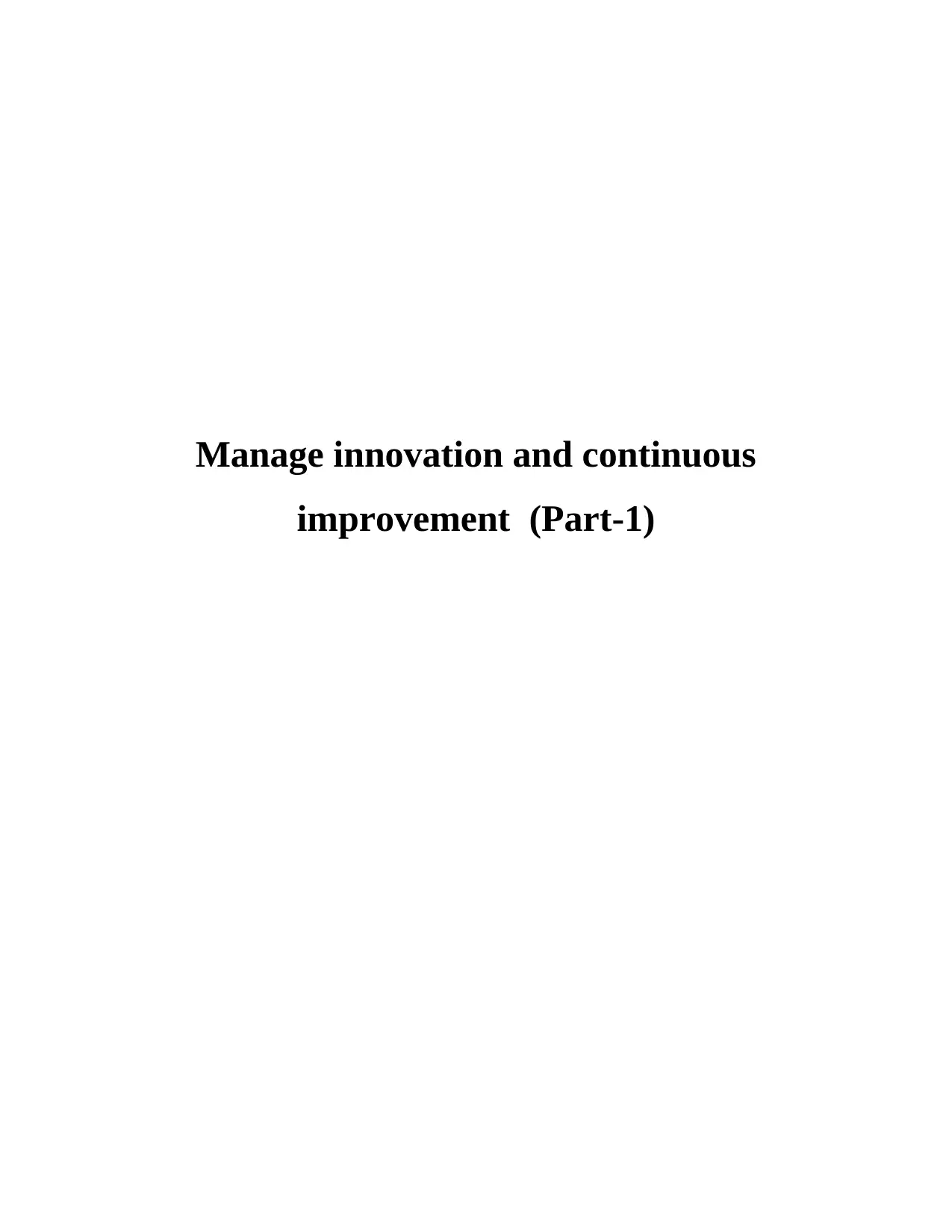
Manage innovation and continuous
improvement (Part-1)
improvement (Part-1)
Paraphrase This Document
Need a fresh take? Get an instant paraphrase of this document with our AI Paraphraser

Table of Contents
Introduction......................................................................................................................................1
Key systems and processes used by Australian hardware...............................................................1
Analyzing the key systems and processes.......................................................................................1
Applying Total quality management theory....................................................................................1
Key result areas and performance indicators...................................................................................2
SWOT Analysis of Australian hardware till 1960...........................................................................3
References:......................................................................................................................................4
List of figure
Figure 1: Structure of Total quality management............................................................................2
List of tables
Table 1: Key systems and processes................................................................................................1
Table 2: List of KPA's and KRA's...................................................................................................2
Table 3: SWOT Analysis.................................................................................................................3
Introduction......................................................................................................................................1
Key systems and processes used by Australian hardware...............................................................1
Analyzing the key systems and processes.......................................................................................1
Applying Total quality management theory....................................................................................1
Key result areas and performance indicators...................................................................................2
SWOT Analysis of Australian hardware till 1960...........................................................................3
References:......................................................................................................................................4
List of figure
Figure 1: Structure of Total quality management............................................................................2
List of tables
Table 1: Key systems and processes................................................................................................1
Table 2: List of KPA's and KRA's...................................................................................................2
Table 3: SWOT Analysis.................................................................................................................3
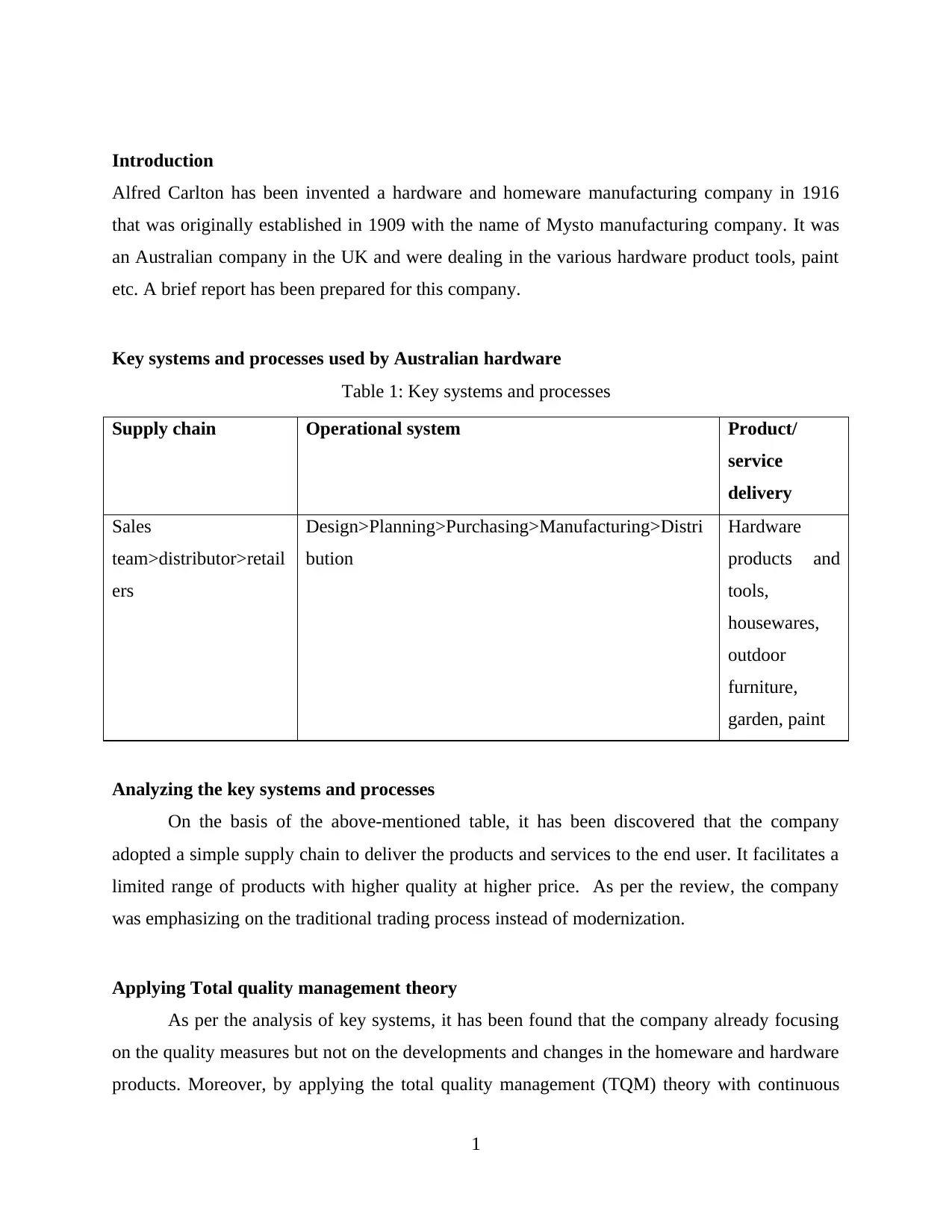
Introduction
Alfred Carlton has been invented a hardware and homeware manufacturing company in 1916
that was originally established in 1909 with the name of Mysto manufacturing company. It was
an Australian company in the UK and were dealing in the various hardware product tools, paint
etc. A brief report has been prepared for this company.
Key systems and processes used by Australian hardware
Table 1: Key systems and processes
Supply chain Operational system Product/
service
delivery
Sales
team>distributor>retail
ers
Design>Planning>Purchasing>Manufacturing>Distri
bution
Hardware
products and
tools,
housewares,
outdoor
furniture,
garden, paint
Analyzing the key systems and processes
On the basis of the above-mentioned table, it has been discovered that the company
adopted a simple supply chain to deliver the products and services to the end user. It facilitates a
limited range of products with higher quality at higher price. As per the review, the company
was emphasizing on the traditional trading process instead of modernization.
Applying Total quality management theory
As per the analysis of key systems, it has been found that the company already focusing
on the quality measures but not on the developments and changes in the homeware and hardware
products. Moreover, by applying the total quality management (TQM) theory with continuous
1
Alfred Carlton has been invented a hardware and homeware manufacturing company in 1916
that was originally established in 1909 with the name of Mysto manufacturing company. It was
an Australian company in the UK and were dealing in the various hardware product tools, paint
etc. A brief report has been prepared for this company.
Key systems and processes used by Australian hardware
Table 1: Key systems and processes
Supply chain Operational system Product/
service
delivery
Sales
team>distributor>retail
ers
Design>Planning>Purchasing>Manufacturing>Distri
bution
Hardware
products and
tools,
housewares,
outdoor
furniture,
garden, paint
Analyzing the key systems and processes
On the basis of the above-mentioned table, it has been discovered that the company
adopted a simple supply chain to deliver the products and services to the end user. It facilitates a
limited range of products with higher quality at higher price. As per the review, the company
was emphasizing on the traditional trading process instead of modernization.
Applying Total quality management theory
As per the analysis of key systems, it has been found that the company already focusing
on the quality measures but not on the developments and changes in the homeware and hardware
products. Moreover, by applying the total quality management (TQM) theory with continuous
1
⊘ This is a preview!⊘
Do you want full access?
Subscribe today to unlock all pages.

Trusted by 1+ million students worldwide
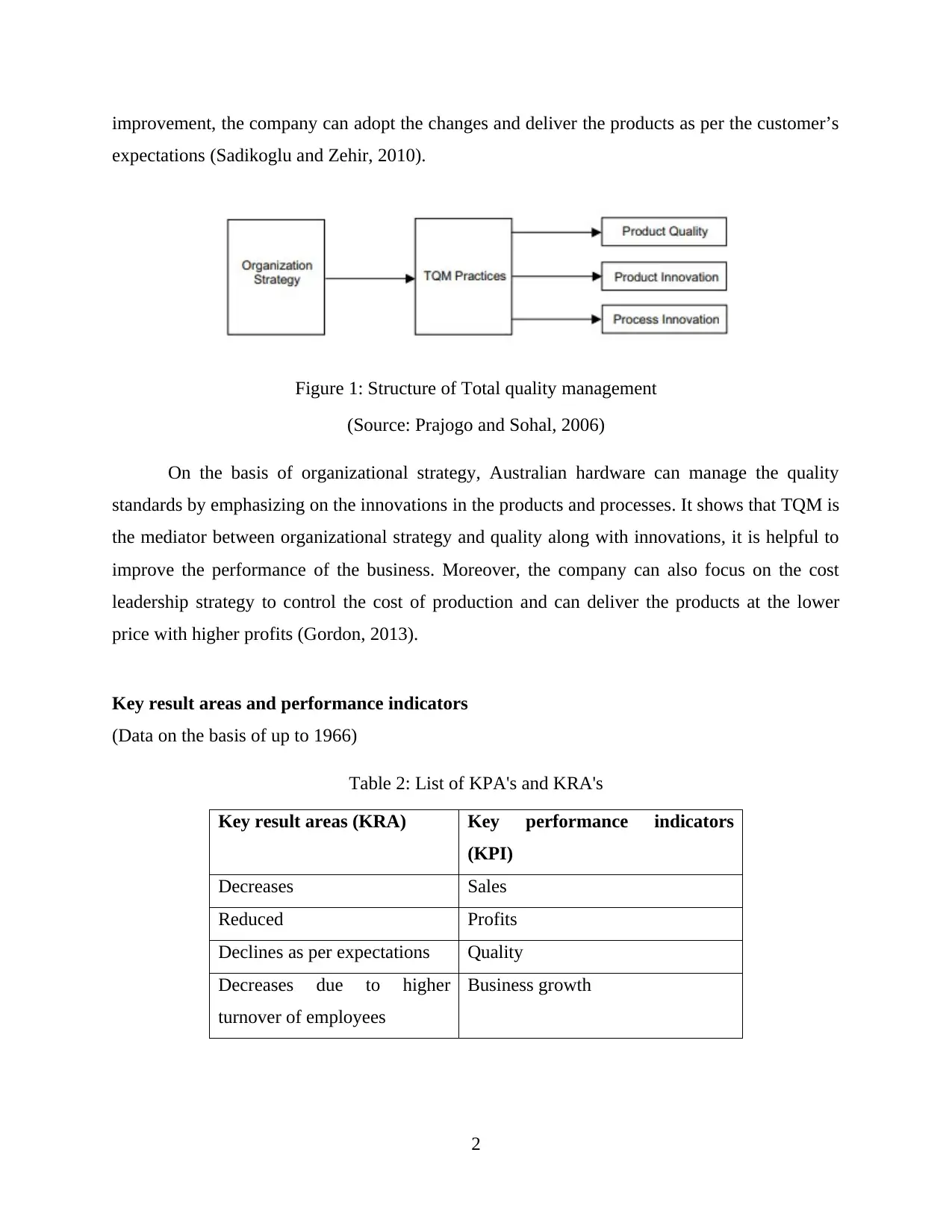
improvement, the company can adopt the changes and deliver the products as per the customer’s
expectations (Sadikoglu and Zehir, 2010).
Figure 1: Structure of Total quality management
(Source: Prajogo and Sohal, 2006)
On the basis of organizational strategy, Australian hardware can manage the quality
standards by emphasizing on the innovations in the products and processes. It shows that TQM is
the mediator between organizational strategy and quality along with innovations, it is helpful to
improve the performance of the business. Moreover, the company can also focus on the cost
leadership strategy to control the cost of production and can deliver the products at the lower
price with higher profits (Gordon, 2013).
Key result areas and performance indicators
(Data on the basis of up to 1966)
Table 2: List of KPA's and KRA's
Key result areas (KRA) Key performance indicators
(KPI)
Decreases Sales
Reduced Profits
Declines as per expectations Quality
Decreases due to higher
turnover of employees
Business growth
2
expectations (Sadikoglu and Zehir, 2010).
Figure 1: Structure of Total quality management
(Source: Prajogo and Sohal, 2006)
On the basis of organizational strategy, Australian hardware can manage the quality
standards by emphasizing on the innovations in the products and processes. It shows that TQM is
the mediator between organizational strategy and quality along with innovations, it is helpful to
improve the performance of the business. Moreover, the company can also focus on the cost
leadership strategy to control the cost of production and can deliver the products at the lower
price with higher profits (Gordon, 2013).
Key result areas and performance indicators
(Data on the basis of up to 1966)
Table 2: List of KPA's and KRA's
Key result areas (KRA) Key performance indicators
(KPI)
Decreases Sales
Reduced Profits
Declines as per expectations Quality
Decreases due to higher
turnover of employees
Business growth
2
Paraphrase This Document
Need a fresh take? Get an instant paraphrase of this document with our AI Paraphraser
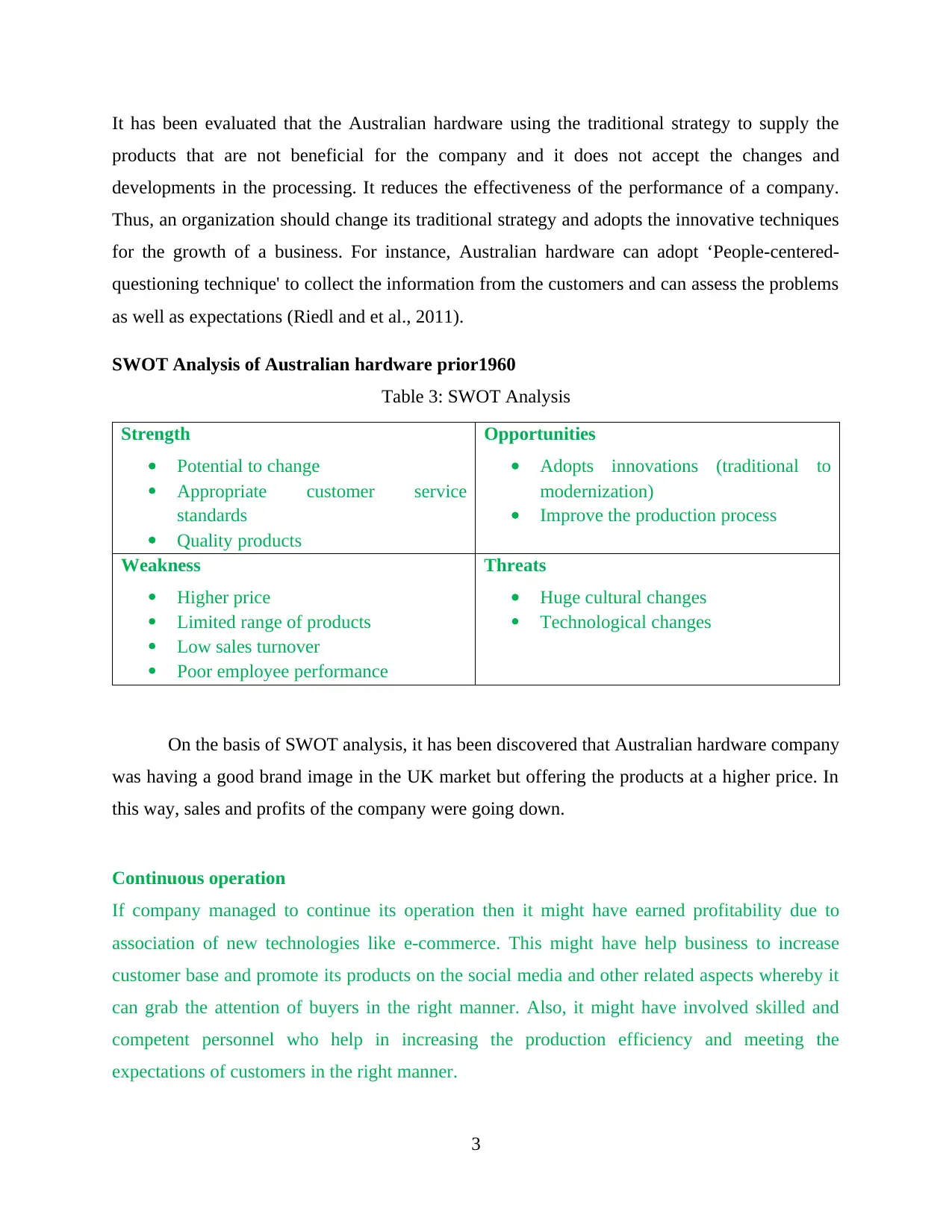
It has been evaluated that the Australian hardware using the traditional strategy to supply the
products that are not beneficial for the company and it does not accept the changes and
developments in the processing. It reduces the effectiveness of the performance of a company.
Thus, an organization should change its traditional strategy and adopts the innovative techniques
for the growth of a business. For instance, Australian hardware can adopt ‘People-centered-
questioning technique' to collect the information from the customers and can assess the problems
as well as expectations (Riedl and et al., 2011).
SWOT Analysis of Australian hardware prior1960
Table 3: SWOT Analysis
Strength
Potential to change
Appropriate customer service
standards
Quality products
Opportunities
Adopts innovations (traditional to
modernization)
Improve the production process
Weakness
Higher price
Limited range of products
Low sales turnover
Poor employee performance
Threats
Huge cultural changes
Technological changes
On the basis of SWOT analysis, it has been discovered that Australian hardware company
was having a good brand image in the UK market but offering the products at a higher price. In
this way, sales and profits of the company were going down.
Continuous operation
If company managed to continue its operation then it might have earned profitability due to
association of new technologies like e-commerce. This might have help business to increase
customer base and promote its products on the social media and other related aspects whereby it
can grab the attention of buyers in the right manner. Also, it might have involved skilled and
competent personnel who help in increasing the production efficiency and meeting the
expectations of customers in the right manner.
3
products that are not beneficial for the company and it does not accept the changes and
developments in the processing. It reduces the effectiveness of the performance of a company.
Thus, an organization should change its traditional strategy and adopts the innovative techniques
for the growth of a business. For instance, Australian hardware can adopt ‘People-centered-
questioning technique' to collect the information from the customers and can assess the problems
as well as expectations (Riedl and et al., 2011).
SWOT Analysis of Australian hardware prior1960
Table 3: SWOT Analysis
Strength
Potential to change
Appropriate customer service
standards
Quality products
Opportunities
Adopts innovations (traditional to
modernization)
Improve the production process
Weakness
Higher price
Limited range of products
Low sales turnover
Poor employee performance
Threats
Huge cultural changes
Technological changes
On the basis of SWOT analysis, it has been discovered that Australian hardware company
was having a good brand image in the UK market but offering the products at a higher price. In
this way, sales and profits of the company were going down.
Continuous operation
If company managed to continue its operation then it might have earned profitability due to
association of new technologies like e-commerce. This might have help business to increase
customer base and promote its products on the social media and other related aspects whereby it
can grab the attention of buyers in the right manner. Also, it might have involved skilled and
competent personnel who help in increasing the production efficiency and meeting the
expectations of customers in the right manner.
3

4
⊘ This is a preview!⊘
Do you want full access?
Subscribe today to unlock all pages.

Trusted by 1+ million students worldwide
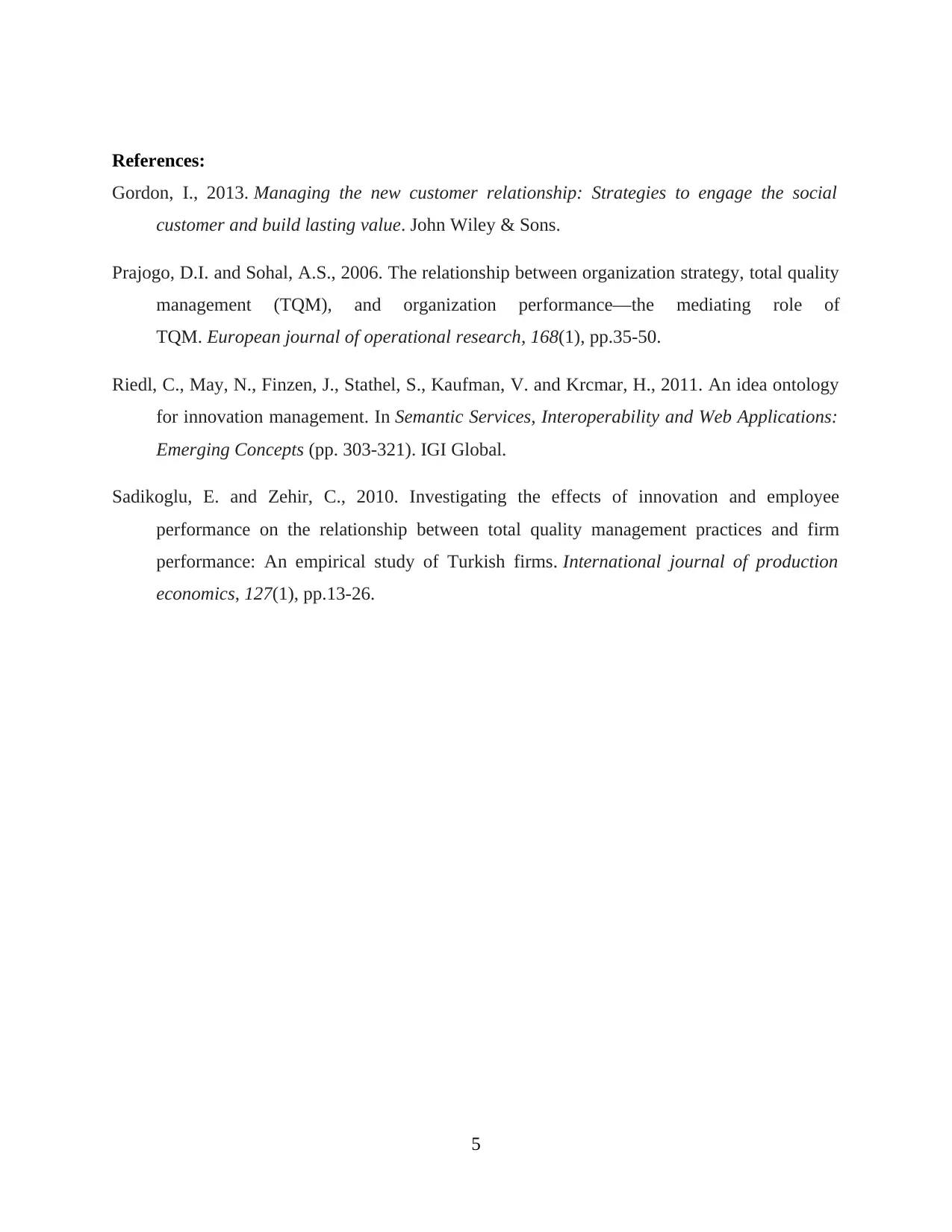
References:
Gordon, I., 2013. Managing the new customer relationship: Strategies to engage the social
customer and build lasting value. John Wiley & Sons.
Prajogo, D.I. and Sohal, A.S., 2006. The relationship between organization strategy, total quality
management (TQM), and organization performance––the mediating role of
TQM. European journal of operational research, 168(1), pp.35-50.
Riedl, C., May, N., Finzen, J., Stathel, S., Kaufman, V. and Krcmar, H., 2011. An idea ontology
for innovation management. In Semantic Services, Interoperability and Web Applications:
Emerging Concepts (pp. 303-321). IGI Global.
Sadikoglu, E. and Zehir, C., 2010. Investigating the effects of innovation and employee
performance on the relationship between total quality management practices and firm
performance: An empirical study of Turkish firms. International journal of production
economics, 127(1), pp.13-26.
5
Gordon, I., 2013. Managing the new customer relationship: Strategies to engage the social
customer and build lasting value. John Wiley & Sons.
Prajogo, D.I. and Sohal, A.S., 2006. The relationship between organization strategy, total quality
management (TQM), and organization performance––the mediating role of
TQM. European journal of operational research, 168(1), pp.35-50.
Riedl, C., May, N., Finzen, J., Stathel, S., Kaufman, V. and Krcmar, H., 2011. An idea ontology
for innovation management. In Semantic Services, Interoperability and Web Applications:
Emerging Concepts (pp. 303-321). IGI Global.
Sadikoglu, E. and Zehir, C., 2010. Investigating the effects of innovation and employee
performance on the relationship between total quality management practices and firm
performance: An empirical study of Turkish firms. International journal of production
economics, 127(1), pp.13-26.
5
1 out of 7
Related Documents
Your All-in-One AI-Powered Toolkit for Academic Success.
+13062052269
info@desklib.com
Available 24*7 on WhatsApp / Email
![[object Object]](/_next/static/media/star-bottom.7253800d.svg)
Unlock your academic potential
Copyright © 2020–2025 A2Z Services. All Rights Reserved. Developed and managed by ZUCOL.




